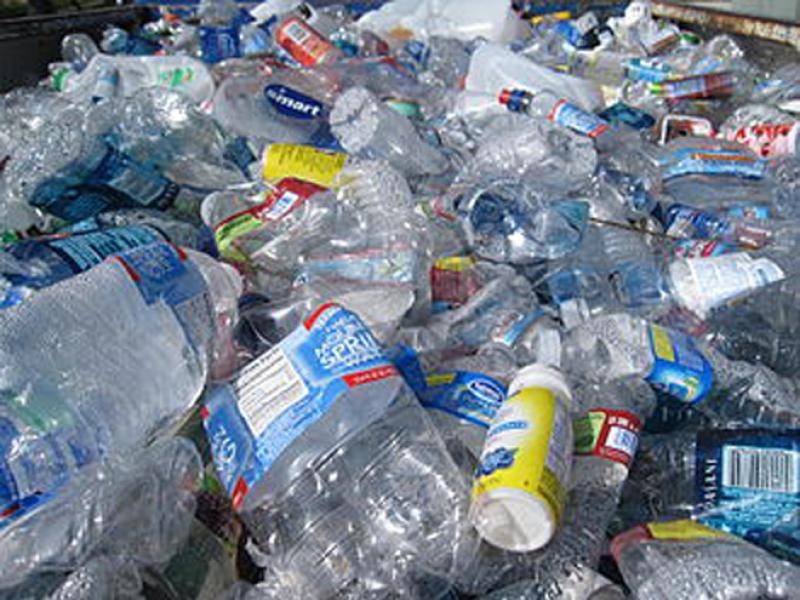Jun 13 2018
Certain plastics can be broken down by enzymes found in nature, however, not well enough to aid industrial recycling and curtail the scourge of plastic waste. Based on what nature has provided, scientists at Rensselaer Polytechnic Institute have enhanced the efficiency of a leaf and branch compost cutinase that is capable of breaking down polyethylene terephthalate (PET), the plastic used in colored as well as clear plastic water bottles and numerous other products. Scientists are certain the enzyme can be further enhanced, offering a favorable option for fuel limitless recycling of PET and probably other plastics such as cellulose acetate.
 Credit: Rensselaer Polytechnic Institute
Credit: Rensselaer Polytechnic Institute
In a study now reported in the journal Biochemistry, the scientists used yeast cells to express the leaf and branch compost cutinase (LCC) altered by the inclusion of sugar molecules — or glycans — in two locations. The “glycosylated” altered enzyme retained no less than half of its activity after 48 hours at 75 °C, versus a formerly reported half-life of 40 minutes for the unchanged enzyme at 70 °C.
“We need plastics and other materials that retain good performance and, after use, can then be broken down by safe and mild processes to their original building blocks for reuse,” said Richard Gross, lead author of the research, Constellation Professor of Biocatalysis and Metabolic Engineering, member of the Center for Biotechnology and Interdisciplinary Studies, and Professor of Chemistry and Chemical Biology at Rensselaer.
The goal should be zero waste and to do that, we have to build reuse into the design of a wide range of polymers and materials. This is an encouraging step toward that goal.
Richard Gross, Lead author of the research
“This promising advance, which is sorely needed as plastic pollution becomes an ever-greater threat to our environment, is a result of the diverse skill set and collaborative environment we have built at Rensselaer, ” said Deepak Vashishth, director of the Center for Biotechnology and Interdisciplinary Studies. “Dr. Gross’ research spans boundaries between biologics and biomanufacturing, and is certain to help us resolve the critical problems we face.”
With current technologies, a plastic bottle is mostly down-cycled instead of recycled. After one use, a high percentage of PET bottles directly get sent to landfills or are reused as other plastics such as PET fibers and fleece for furniture, clothes, bags, carpet, and packing materials. Ultimately, down-cycled PET winds up in landfills or other environments such as lakes and oceans, a fate numerous consumers are ignorant about as they throw their water bottles in a recycling bin.
By breaking down PET into its building blocks — ethylene glycol and terephthalic acid — the limitless reuse more frequently linked with other recyclable materials such as metal and glass can be facilitated. Some enzymes that naturally occur can break down PET, but not within the limits of temperature and time vital by an industrial recycling process. A number of enzymes lose their activity when the temperatures increase, and ultimately denature. An enzyme ideal for industrial recycling must be capable of working at the optimal temperature for breaking down PET, which is about 75 °C, and it must retain its activity sufficiently long to accomplish its job economically at that temperature.
LCC was primarily learned through metagenomic analysis of a leaf-branch compost, meaning researchers took out DNA found in a compost regardless of the organisms that created it, and then used the DNA to define and catalog enzymes that were present. A 2012 research published by unrelated scientists in the journal Applied and Environmental Microbiology revealed that LCC was able to hydrolyze, or break down, PET, but could not retain activity at higher temperatures. That gained the attention of Gross, an expert on biocatalytic and chemical synthetic techniques, who saw the chance to enhance the enzyme’s “kinetic stability” without ruining its capability to break down PET.
The lab examined the enzyme and discovered three distinct glycosylation sites, amino acid sequences to which glycans are connected during protein synthesis. Gross said the glycosylation locations could have progressed in an earlier organism and been conserved although they were not used by the natural bacterium that initially formed this protein. Irrespective, when the researchers expressed the enzyme using the yeast strain Pichia pastoris, they discovered that the yeast naturally glycosylated the enzyme at the three locations. Additional research revealed that two glycosylation locations produced a more effective enzyme than three locations.
With just those slight changes, the researchers witnessed a greater than 60-fold enhancement in kinetic stability. Gross said more research will be done to explore how to additionally enhance the kinetics and the total activity of the enzyme by testing with amino acid sequences to develop variant structures. Through this research, Gross hopes to comprehend the design rules that bring about better performance.
This cutinase is an excellent candidate for commercialization, but this work will also help us redesign other cutinases to break down other polymers, and that’s a much larger end game.
Richard Gross, Lead author of the research
The research paper titled “Stabilizing Leaf and Branch Compost Cutinase (LCC) with Glycosylation: Mechanism and Effect on PET Hydrolysis” has been published in Biochemistry, and the study was financially supported by the National Science Foundation.
Study on renewable synthetic materials realizes The New Polytechnic, an upcoming paradigm for higher education which recognizes that global issues and opportunities are so huge they cannot be satisfactorily addressed by even the most brilliant person working solo. Rensselaer serves as a crossroads for partnerships — working with collaborators across disciplines, geographic regions, and sectors — to address tough global challenges, using the most advanced technologies and tools, many of which are designed at Rensselaer. Research conducted at Rensselaer looks into some of the world’s most immediate technological challenges — from energy security and sustainable development to human health and biotechnology. The New Polytechnic is transformative in the global impact of research, in its original pedagogy, and in the lives of students at Rensselaer.